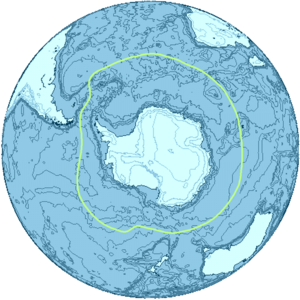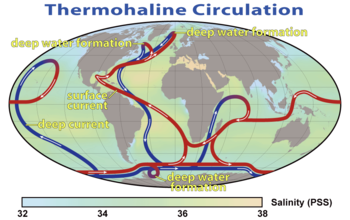
A | B | C | D | E | F | G | H | CH | I | J | K | L | M | N | O | P | Q | R | S | T | U | V | W | X | Y | Z | 0 | 1 | 2 | 3 | 4 | 5 | 6 | 7 | 8 | 9

The subantarctic zone[1] is a region in the Southern Hemisphere, located immediately north of the Antarctic region. This translates roughly to a latitude of between 46° and 60° south of the Equator. The subantarctic region includes many islands in the southern parts of the Atlantic, Indian, and Pacific oceans, especially those situated north of the Antarctic Convergence. Subantarctic glaciers are, by definition, located on islands within the subantarctic region. All glaciers located on the continent of Antarctica are by definition considered to be Antarctic glaciers.
Geography
The subantarctic region comprises two geographic zones and three distinct fronts. The northernmost boundary of the subantarctic region is the rather ill-defined Subtropical Front (STF), also referred to as the Subtropical Convergence. To the south of the STF is a geographic zone, the Subantarctic Zone (SAZ). South of the SAZ is the Subantarctic Front (SAF). South of the SAF is another marine zone, called the Polar Frontal Zone (PFZ). The SAZ and the PFZ together form the subantarctic region. The southernmost boundary of the PFZ (and hence, the southern border of the subantarctic region) is the Antarctic Convergence, located approximately 200 kilometers south of the Antarctic Polar Front (APF).[2]
Influence of the Antarctic Circumpolar Current and thermohaline circulation


The subantarctic Front, found between 48°S and 58°S in the Indian and Pacific Ocean and between 42°S and 48°S in the Atlantic Ocean, defines the northern boundary of the Antarctic Circumpolar Current (or ACC).[2] The ACC is the most important ocean current in the Southern Ocean, and the only current that flows completely around the Earth. Flowing eastward through the southern portions of the Atlantic, Indian, and Pacific Oceans, the ACC links these three otherwise separate oceanic basins. Extending from the sea surface to depths of 2000–4000 meters, and with a width of as great as 2000 kilometers, the ACC transports more water than any other ocean current.[3] The ACC carries up to 150 Sverdrups (150 million cubic meters per second), equivalent to 150 times the volume of water flowing in all the world's rivers.[4] The ACC and the global thermohaline circulation strongly influence regional and global climate as well as underwater biodiversity.[5]
Another factor that contributes to the climate of the subantarctic region, though to a much lesser extent than the thermohaline circulation, is the formation of Antarctic Bottom Water (ABW) by halothermal dynamics. The halothermal circulation is that portion of the global ocean circulation that is driven by global density gradients created by surface heat and evaporation.
Definition of subantarctic: political versus scientific

Several distinct water masses converge in the immediate vicinity of the APF or Antarctic Convergence (in particular the Subantarctic Surface Water (Subantarctic Mode Water or SAMW), Antarctic Surface Water, and the Antarctic Intermediate Water). This convergence creates a unique environment, noted for its very high marine productivity, especially for antarctic krill. Because of this, all lands and waters situated south of the Antarctic Convergence are considered to belong to the Antarctic from a climatological, biological and hydrological standpoint.[citation needed] However, the text of the Antarctic Treaty, article VI ("Area covered by Treaty") states: "The provisions of the present Treaty shall apply to the area south of 60° South latitude".[6] Therefore, Antarctica is defined from a political standpoint as all land and ice shelves south of 60°S latitude.
Subantarctic islands


At between about 46°–50° south of the Equator, in the region often referred to as the Roaring Forties, are the Crozet Islands, the Prince Edward Islands, Wager Island, the Bounty Islands, the Snares Islands, the Kerguelen Islands, the Antipodes Islands, and the Auckland Islands. The geography of these islands is characterized by tundra, with some trees on the Snares Islands and the Auckland Islands. These islands are all located near the Antarctic Convergence (with the Kerguelen Islands south of the Convergence) and are properly considered to be subantarctic islands.
At between 51°–56° south of the Equator, the Falkland Islands, Isla de los Estados, Ildefonso Islands, Diego Ramírez Islands, and other islands associated with Tierra del Fuego and Cape Horn, lie north of the Antarctic Convergence in the region often referred to as the Furious Fifties. Unlike other subantarctic islands, these islands have trees, temperate grasslands (mostly tussac grass), and even arable land. They also lack tundra and permanent snow and ice at their lowest elevations. Despite their more southerly location, it is debatable whether these islands should be considered as such because their climate and geography differs significantly from other subantarctic islands.
At between 52°–57° south of the Equator, the Campbell Island Group, Heard Island and McDonald Islands, Bouvet Island, the South Georgia Group, Macquarie Island, and the South Sandwich Islands are also located in the Furious Fifties. The geography of these islands is characterized by tundra, permafrost, and volcanoes. These islands are situated close to or south of the Antarctic Convergence, but north of 60° S latitude (the continental limit according to the Antarctic Treaty).[6] Therefore, although some are located south of the Antarctic Convergence, they should still be considered as subantarctic islands by virtue of their location north of 60° S.[citation needed]
At between 60°–69° south of the Equator, in the region often referred to as the Shrieking Sixties, the South Orkney Islands, South Shetland Islands, Balleny Islands, Scott Island, and Peter I Island are all properly considered to be Antarctic islands for the following three reasons:
- they are all located south of the Antarctic Convergence
- they are all located within the Southern (or Antarctic) Ocean
- they are all located south of the 60th parallel south
In light of the above considerations, the following should be considered to be subantarctic islands:
Subantarctic glaciers
This is a list of glaciers in the subantarctic. This list includes one snow field (Murray Snowfield). Snow fields are not glaciers in the strict sense of the word, but they are commonly found at the accumulation zone or head of a glacier.[9] For the purposes of this list, Antarctica is defined as any latitude further south than 60° (the continental limit according to the Antarctic Treaty).[6]





